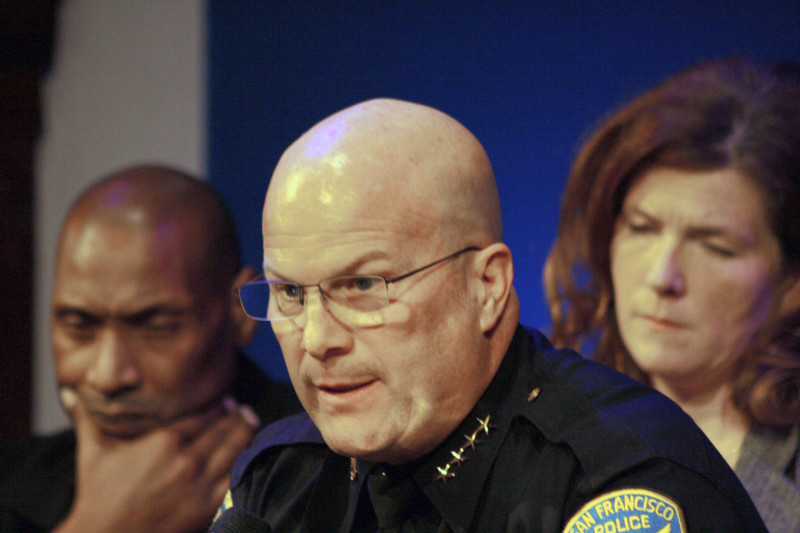"That's just not true," Suhr said. "The responding officers did a good investigation."
But the case did not go beyond that initial response.
"When it came across the senior investigator's desk for review, he or she decided that that initial investigation was all that there was, and it didn't merit a follow investigation. ... There was an investigation; there just wasn't much to go on," Suhr said.
Civil Settlement
This one involves Suhr himself, and his decision to fire former SFPD internal affairs attorney Kelly O’Haire quickly after he became chief of police in 2011. O'Haire asserted in a lawsuit that she was fired in retaliation for investigating allegations of misconduct against Suhr.
The San Francisco Examiner reported extensively on the lawsuit, until the city and O'Haire agreed to a $725,000 settlement on April 24. The settlement effectively ended proceedings that would have explored allegations that Suhr lied to the FBI to obtain security clearance and failed to properly report a domestic violence incident involving a friend of his who was attacked.
"I was faced with having to close a seven-figure budget gap, actually eight-figure budget gap," Suhr said. "Ms. O'Haire was a middle manager, and one of the positions identified that was, at the time, something we could manage without. I made that decision."
But, Suhr said, the settlement revealed "there was a fact that might have allowed Ms. O'Haire to stay on longer."
"Hopefully this makes things right for Ms. O'Haire as well," he said.
Amilcar Perez Lopez
Details from an independent autopsy of the 20-year-old Guatemalan immigrant, shot and killed by plainclothes SFPD officers on Feb. 26, appear to contradict Suhr's narrative of the incident given just two days later.
Suhr said on March 2 that two plainclothes officers fired at Amilcar Perez Lopez as he charged at one of them with a knife. The autopsy, released April 24 by an attorney representing Perez Lopez's family, found Perez Lopez was shot six time from behind.
"Mr. Lopez ... came at the officers with the knife, and then the officers fired," Suhr said. "And he turned away, which would explain not all the rounds going in the front."
Textgate
Seven SFPD officers facing termination for swapping racist, sexist, anti-gay and otherwise offensive text messages with convicted ex-Sgt. Ian Furminger were able to halt disciplinary proceedings by petitioning a Superior Court judge.
The court ordered the officers placed back on paid leave while the city and their attorneys litigate how the one-year statute of limitations for disciplining police officers should apply to the case.
Suhr first said that a court order prohibited the department from acting on evidence turned over to the Internal Affairs Division in December 2012 until the federal corruption investigation into Furminger and six other plainclothes SFPD officers was completed -- and that he was "walled off" from evidence of the text messages until early 2015.
When no such court order was found to exist, Suhr referenced a federal rule of criminal procedure that keeps parts of criminal grand jury proceedings secret.
"As the criminal case was proceeding," Suhr said Monday, "the officers were basically sworn or had an understanding with the U.S. Attorney's Office that whatever came under their information as cooperating investigators in this case, they were not to cross over and tell people on the administrative side, which would have been me or other higher-ups in the Police Department."
Suhr has cited a provision of the California Public Safety Officers Procedural Bill of Rights that "tolls," or pauses the statute of limitations, if an officer is the subject of a criminal investigation. But the officers argue the texts in question were incidental to a criminal investigation, not part of it.
They've convinced a Superior Court judge to at least hear their case, and the court stayed any disciplinary actions against the officers until the issue is tried. The officers were placed back on paid administrative leave in May.
Theft and Disparity, Death and Staffing
Suhr said SFPD's current sworn staffing -- some 300 officers below the minimum 1,971 defined in the City Charter -- is affecting response times, even for calls about potential violence or crimes in progress, which are the department's highest priority.
"It takes about 45 seconds to a minute longer than it used to even on the A priority calls," Suhr said. "The good news is all those cops are coming back."
The department plans to graduate five new police academy classes over the coming year, and three more next year.
Despite the short staff, shootings and homicides have both been halved since 2008, Suhr said, but certain districts in the city -- particularly those with minority communities -- haven't seen it.
"There's also sadly a disproportionate amount of violent crime that occurs in these same neighborhoods," Suhr said. "Almost 50 percent of the homicides this year, even though homicides are again lower than what they were dramatically from 2007 and 2008, disproportionately affecting African-American men."
Factoring the estimate that African-Americans make up about 6 percent of San Francisco's population, Suhr said African-Americans are about eight times more likely to be victims of homicide than other races in the city.
Property crimes, which are up throughout the state, are also climbing in San Francisco.
"We've seen a significant rise in auto burglaries, to the tune of well over 50 percent, a lot of property crime," he said.
Recent reports have solidified San Francisco's dubious distinction as having one of the widest racially disparate criminal justice systems in the state, with African-Americans about seven times more likely to be arrested than white people in the city.
Suhr said a recent tracking effort by the department shows the race of arrested suspects almost always matches the description given by victims or witnesses to the crime.
